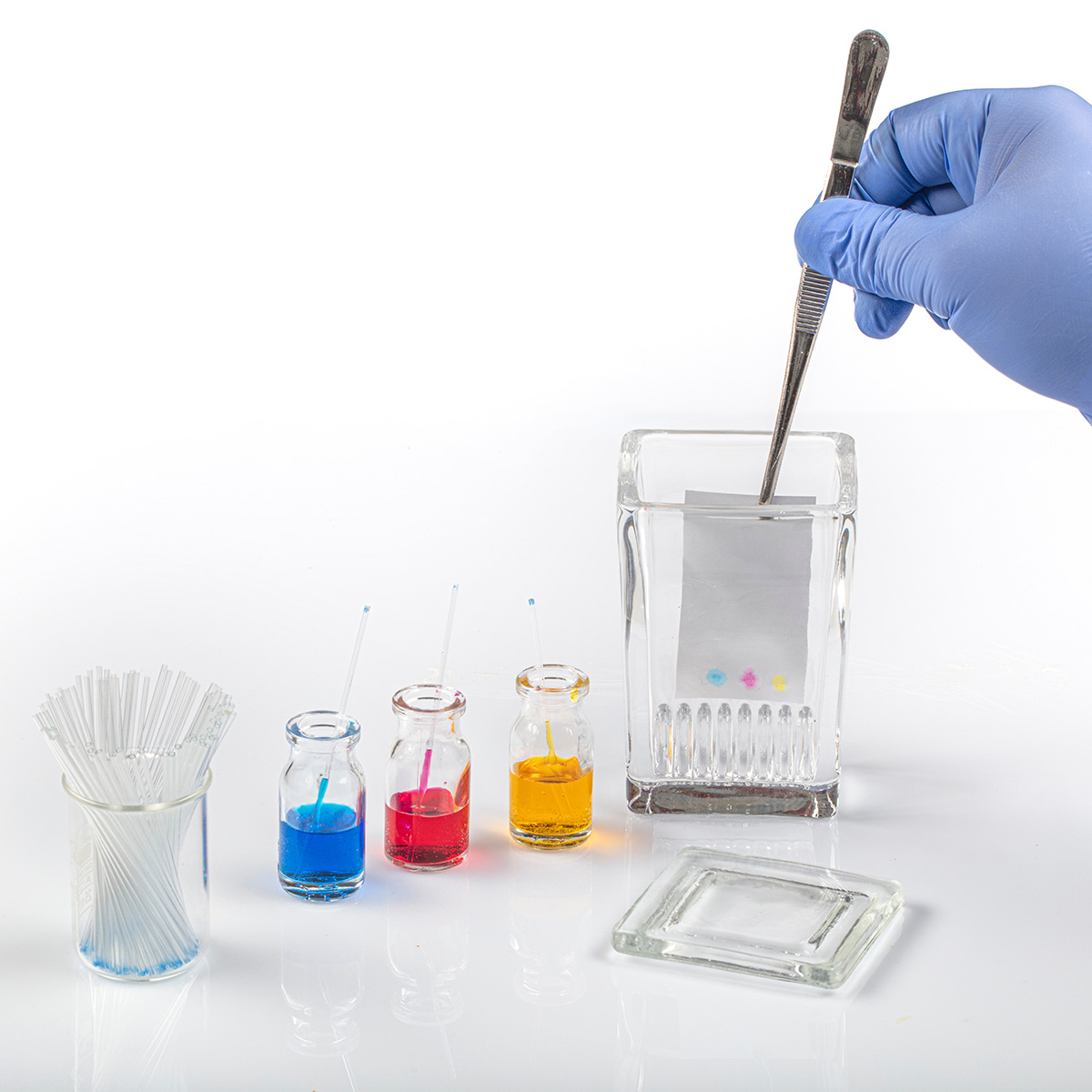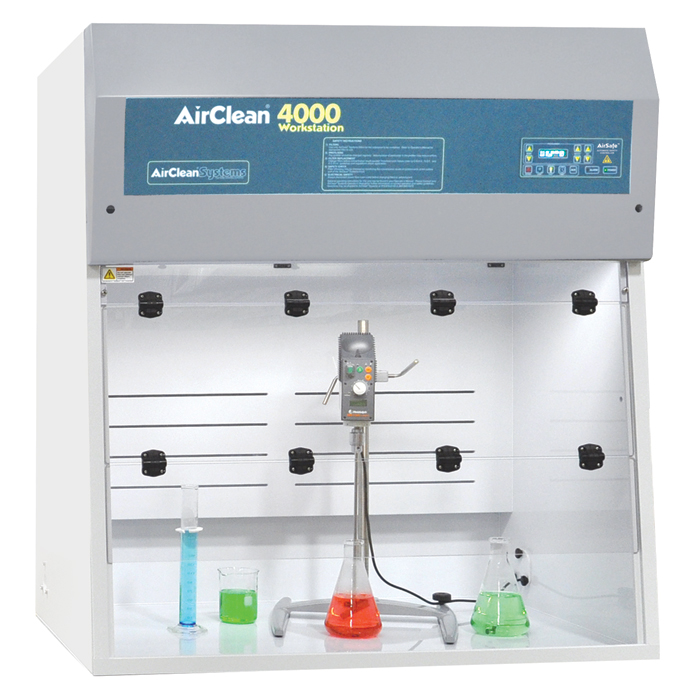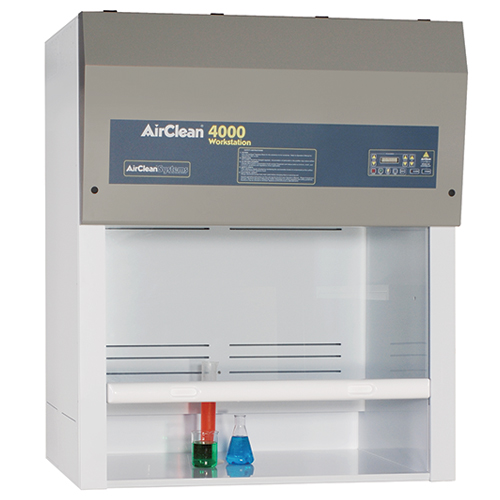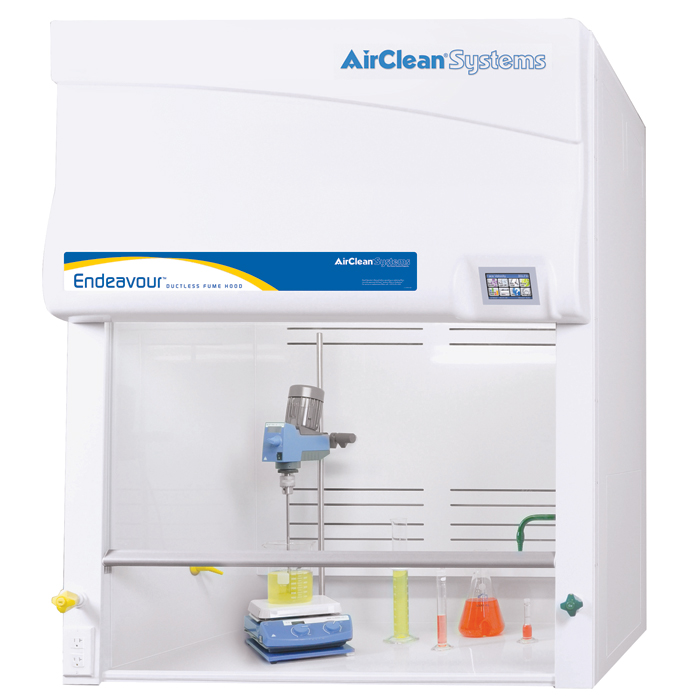
Chromatography Safety
What Is Chromatography?
Chromatography is a method used for separating chemical components from a chemical mixture. All chromatography methods utilize a stationary phase, typically a piece of paper or a packed column upon which the chemical components are adsorbed or partitioned. The mobile phase is a liquid or gas that elutes or extracts the components from the solid stationary phase. As the names imply, the stationary phase is fixed in place, while the mobile phase (a gas or liquid) mixes or interacts with the sample and moves from one end of the paper/column to the other. The sample components are separated based upon their interactions with the stationary and/or mobile phase. The stronger the interaction between the chemical component and the stationary/mobile phase, the slower the chemical component will move across the stationary phase solid; allowing slower moving components to be separated from faster moving ones. Once the components are separated, they can be identified and/or quantified by various techniques.
Chromatography Applications
Chromatography is widely used across many disciplines and industries. Chemists use chromatography extensively for research and development, while forensics teams employ chromatography methods to identify illicit substances, analyze bodily fluids, screen for toxins, and identify accelerants used in fires. Chromatography can also identify potential contaminants in defined chemical mixtures making it an excellent quality control method to analyze the purity of manufactured drugs, vaccines, and food. Similarly, environmental scientists use chromatography to detect contaminating pesticides and pollutants in air, soil, and water samples. These are just a few of the many ways chromatography methods are used in industry, academic, and government laboratories.
Types of Chromatography
The ability to modify the identity and reactivity of the stationary and mobile phases makes the potential applications for chromatography seemingly endless. To increase its utility even more, multiple chromatography methods have been developed to facilitate analysis of many sample types. These methods fall into one of four categories: paper and thin layer chromatography, liquid chromatography, gas chromatography, and electrophoresis.Paper and thin layer chromatography (TLC)-Paper chromatography is considered one of the simplest forms of chromatography. A droplet of a chemical mixture in a solvent is applied to cellulose paper. A portion of the paper is immersed into the solvent (mobile phase), so that the solvent is drawn up the length of the paper by capillary action. The separated components can be identified visually by comparisons to known standards. Thin layer chromatography (TLC) is similar, but uses silica gel or alumina on glass plates as the stationary phase, instead of cellulose paper.
Liquid chromatography, including high performance liquid chromatography (HPLC)- Liquid chromatography includes two similar techniques: column chromatography and high-performance liquid chromatography (HPLC). In column chromatography, the stationary phase is packed tightly into a vertical column. The sample is added to the top of the packed column followed by the mobile phase or solvent. The solvent and the sample flow through the column by gravity and fractions of solvent/sample mixture are collected from the bottom of the column for further analysis. High performance liquid chromatography (HPLC) is a more efficient form of column chromatography that utilizes a pump to push the solvent and sample through the column to decrease the time required to move through the column.
Gas chromatography - Gas chromatography is similar to liquid chromatography in that the sample must pass through a packed column. However, the sample is vaporized and travels through the column as a gas. The mobile phase consists of an inert gas, usually helium, that helps the sample travel through the column. Therefore, gas chromatography is the only type of chromatography in which sample interactions with the mobile phase are not required for separation. A limitation of this method is that the chemical components to be separated from the mixture must be volatile under the conditions used for separation.
Electrophoresis- In electrophoresis, an electrical current serves as the principle mobile phase. DNA, RNA, and protein samples are loaded into small wells within a gel or other matrix that is submerged within an electrolyte-containing buffer. An electrical current is then applied to the gel or matrix such that one end of the gel is positively charged, while the other is negatively charged to move the DNA, RNA, or protein molecules from one end of the gel to the other.
Fume Hoods Protect From Chromatography Hazards
Chromatography methods rely on the use of potentially hazardous solvents. Typical solvents can include, but are not limited to, alcohols, ethers, acetonitrile, hydrocarbons like hexane, heptane, and petroleum ether, and ketones or esters such as acetone and ethyl acetate. All of the listed solvents are considered irritants of the skin, eyes, and respiratory tract and are flammable. Exposure to acetonitrile, which is used frequently for HPLC, can be especially dangerous because once in the body, acetonitrile is metabolized into poisonous cyanide. In the case of gas chromatography, the effluent which is a mixture of the gaseous sample and mobile phase must be discharged from the column, which could create hazardous vapors depending upon the sample and mobile phase used. Therefore, caution must be taken to avoid exposure, when completing any chromatography procedure. Hazardous solvent handling should be completed within a hood approved for use with the solvent. A ductless hood with a horizontal laminar flow that pulls air from near the operator and across the workspace can be used to protect operators from vapors. The contaminated workspace air is then drawn up toward the top or back of the hood and should travel through an appropriate carbon filter. The appropriate carbon filter will remove any hazardous solvent vapors before the air is exhausted into the work environment. A ducted fume hood could also be used to protect the operator, but may require building modifications to facilitate ducting and limit the flexibility of workspace setups. In addition to working in a hood, operators should also don proper personal protective equipment (PPE) such as gloves, lab coats, and goggles for the entirety of the procedure to help prevent exposures from splashes.




